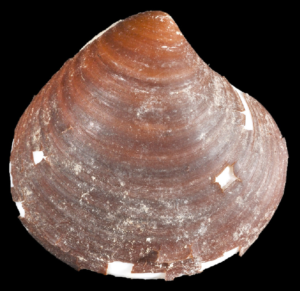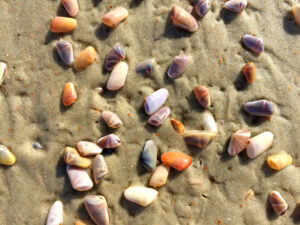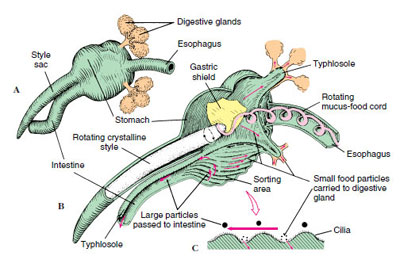
There are many species of clams living in Barnegat Bay.
Hard Clam or Northern Quahog Mercinaria Mercinaria
The hard clam, or northern quahog has long been a main stay of New Jersey’s coastal communities.
Since the resources of the rich coastal bays were first harvested, the clam captured a strong hold in the fresh seafood market and the hearts of the summer residents
In the bay, they start life when sperm and egg unite and develop into a larvae.
The larvae are free swimming until the shells develop and they drop to the mud or sand of the floor of the bay where they burrow in.
Once there, they remain buried extending siphons to draw in water which provides a supply of microscopic plankton as well as oxygen.
They digest the nutriments and expel non-digestible and waste material.
<learn more >
The hard clam, or northern quahog has long been a main stay of New Jersey’s coastal communities.
Since the resources of the rich coastal bays were first harvested, the clam captured a strong hold in the fresh seafood market and the hearts of the summer residents
Soft Shell Clam Mya arenaria
The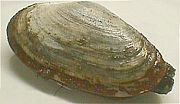 soft shell clam has thin, oval, elongated shells.
soft shell clam has thin, oval, elongated shells.
The shells are chalky white with a thin, parchment-like covering that varies in color from brownish to yellowish to gray.
When closed, the shells gape at both ends and a foot and two siphons protrude from either end. Both siphons are enclosed in a leathery membrane.
The left valve has a spoon-like depression at the hinge.
Soft shell clams grow to about 3 to 4 inches
Fun Fact – Soft Shell Clam are also known as “steamers”, “piss clams”, “softshells”, “longnecks” and in New England “Ipswich clams” or “Essex clams” (towns in Massachusetts)
Atlantic Jackknife Clam or Razor Clam Ensis directus
Razor clams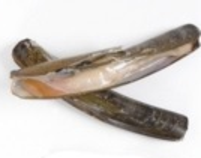
Razor clams average in size between 5-9 inches. Their length is about 6 times their width. They ranges from yellowish to dark brown in color.
They are found in the sand and mud, and are usually dug for by hand but they are hard to catch because of the speed at which they can burrow into the bay bottom.
They have a sweet flavor that is similar to a lobster, but with the same texture and consistency of a clam. They can be consumed raw (on the half-shell), steamed, fried, or cooked in a chowder
Stout Tagelus Tagelus plebeius
 The stout tagelus (is also called the stout razor clam) is similar to the Atlantic Jackknife clam but its shape is shorter and wider.
The stout tagelus (is also called the stout razor clam) is similar to the Atlantic Jackknife clam but its shape is shorter and wider.
They grow to about 3 inches in length with the shell being 3 times longer than it is wide.
They can burrow very rapidly by extending its strong, muscular foot into the bay bottom and pulling the shell down after it.
This species builds a permanent burrow in mud or fine sediment, that will have a J-shape and the end curved upward
Chestnut Astarte Astarte castanea
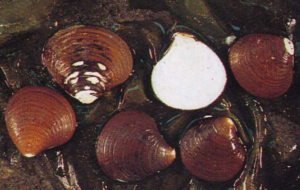 Astarte castanea is a small clam only reaching about 1 inch at maturity.
Astarte castanea is a small clam only reaching about 1 inch at maturity.
It has a periostracum (skin like covering) which is a light brown to chestnut brown color.
The triangular shaped shell as fine, concentric ridges that radiate from its center.
These ridges or grooves are alternatively strong and weak and show through the skin covering.
Jingle Shell Anomia simplex
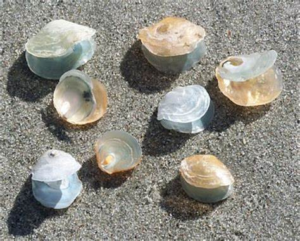 Common jingle shell is a species of bivalve, sharing attributes to blue mussels, eastern oysters, and bay scallops.
Common jingle shell is a species of bivalve, sharing attributes to blue mussels, eastern oysters, and bay scallops.
Although not “clams”, they are very often washed up on the beaches of the barrier islands.
Much more information can be found on the Jungle Shell page <click here>
Ark Clams Family: Arcidae
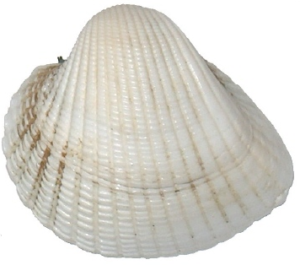 Ark Clams are members of family Arcidae, thus the name “ark”.
Ark Clams are members of family Arcidae, thus the name “ark”.
Characteristics are thick and heavy shells, with a predominantly radiating sculpture.
Arcidae have a taxodont hinge, and the hinge plate is straight, with the teeth increasing in size away from the umbo.
Most species live attached to stones with their byssus, but some live in sand.
Surf Clams
Many species of clams associated with Barnegat Bay live in the ocean
< see more >
Atlantic Surf Clam Spisula solidissima
 The Atlantic Surf Clam is the largest clam on the Atlantic coast. They are not typically found in Barnegat Bay but are abundant in the ocean waters off of Island Beach and Long Beach Island.
The Atlantic Surf Clam is the largest clam on the Atlantic coast. They are not typically found in Barnegat Bay but are abundant in the ocean waters off of Island Beach and Long Beach Island.
< see more >
They range from the beach to a depth of about 200 feet
Surf clams reach harvestable size in about six years. They can reach up to 8 inches, but clams larger than 7 inches are rare.
Adult clams prefer to live in fine to medium grained sandy sediment. This may be in a nearshore location or in open waters that have suitable sandy bottoms, to the 130 foot depth.
Adult surf clams dig into the sandy bottom and normally stay in one location. The ocean, especially near the beach, is much more turbulent than the bay. Storms, waves and strong currents can move them around but they can establish themselves in a new location if the bottom conditions are right. If they can’t dig in, they become vulnerable to predators.
Ocean Quahog Arctica Islandica
 Ocean quahogs are among the longest-lived marine organisms in the world.
Ocean quahogs are among the longest-lived marine organisms in the world.
Off the U.S. East Coast, where the fishery takes place, ocean quahogs can live for as long 200 years (or more).
They grow very slowly and do not start to reproduce until around age 6, and do not reach a commercially harvestable size until about age 20.
see more
Coquina Clams Donax variabilis
Those little clams you see digging in when the waves recede
Coquina clams are a common inhabitant the barrier island’s sandy beaches.
Known for their highly variable color patterns, coquinas can be found buried just under the surface of the sand in the wave-swept area of the beach known as the swash zone.
Because of their size (only 3/4 inch), coquinas are eaten by a variety of sea creatures, including crabs and seabirds.
Like most clams, coquinas use a muscular “foot” to dig themselves under the sand away from harm
Credits
Astarte castanea – Picture by Harvey-Clark, Chris
Jingle shell –o’keefes.org
Coquina – Orlando Sentinel

